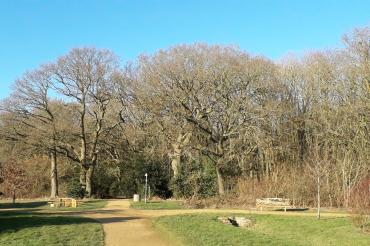Tarman’s Copse is a 9.68 hectare (24 acre) area of ancient woodland in the Jennett’s Park residential area.
The woodland is a remnant of ancient, semi-rural woodland that covered the whole area. It has been in continual use for over 400 years and has changed very little in size or shape since the 1870s.

Tarman’s Copse forms part of an important network of woodland sites across Jennett’s Park, all connected by wildlife corridors.
Archaeological digs in the area close to Tarman’s Copse found evidence of human activity tracing back to the Mesolithic era. However the first permanent roundhouse settlements were found in the Middle Iron Age, with the land supporting one extended family.
The public footpath running alongside Tarman’s Copse is medieval hollow way or sunken lane. These ancient paths could have marked the boundary of 2 land owners estates or were created for driving cattle. The colloquial name of Burnt House Ride was given after a cottage alongside Tarman’s Copse burnt down. It now forms part of a 26 mile circular walking trail known as the Ramblers Route.
Tarman’s Copse is set within Windsor’s deer hunting forest and would originally have been part of the Easthampstead Park estate. A 17th century kiln was excavated nearby, possibly for lime making used in the construction of the first Easthampstead Park House, which is now demolished and re-built in a new location.
Today the woodland consists of older sweet chestnut and veteran oaks with smaller native trees and a ground vegetation layer of Bluebells and Wood Anemone. The buffer areas surrounding the woodland are planted with a variety of fruit trees forming an edible trail throughout Jennett's Park.
Facilities
Facilities include the following:
- maps and noticeboards, including route maps and waymarkers at strategic points around the route
- many places to sit, rest and enjoy the views
- a 1.4km series of surfaced pathways allow access through the wood, many of which are wheelchair accessible
- Green Man sculpture trail with wood carving throughout the woodland copse
How to get to Tarman's Copse
By foot
From the north (Popeswood area):
- follow Beehive Road, head south over the A329 overpass
- turn right onto Peacock Lane
- after 220 metres turn left along Public Footpath 17, you will reach the site after approximately 220 metres
From the south (Great Hollands area):
- travel along Ringmead until Falcon Way
- follow Public Footpath 15 west for 200 metres
- turn north onto Public Footpath 17
- follow the path over Jennett’s Hill grassland area until you reach the site
By car
The site is located at SU 84943 68270, the closest postcode is RG12 8DT.
It is easily accessible from the A329(m):
- exit the motorway onto Peacock Lane
- turn right on the roundabout
- take the next left into the Jennett’s Park residential estate
- follow Sparrowhawk Way until either Osprey Avenue (northern end) or Falcon Way (southern end)
There is no parking on site. You can park on the roadside or in the car park in Tawny Owl Square (off Sparrowhawk Way) which is a 5 minute walk away.
what3words
A what3words address refers to a 3 metre square location. Select the link or enter the 3 words into the free what3words app to find it:
- park location: ///frogs.scenes.shorts
- parking is available at: ///foods.puddles.select
Park management
Our rangers carry out routine tree inspections to check the health of the trees and identify any work that might be required.
Site management includes coppicing the trees in the woodland, revitalising this traditional practice.
Coppicing increases the health and safety of the trees. It also allows more light which encourages undergrowth. Work is carried out in the autumn and winter, outside of bird nesting season.
Older trees will undergo ‘haloing’ a practice to remove competitive trees from around the base.
We allow deadwood to stand, where is safe to do so, as this provides a habitat for lots of different wildlife.
Removing any non-native invasive species, such as Laurel and Rhododendron, helps to increase the biodiversity of the woodland.
We also provide wildlife features such as wood piles, stag beetles loggeries and bat and bird boxes where appropriate.
Wildlife
There is a wealth of wildlife to be found in this urban woodland site. Many ancient woodland species can be seen, especially in spring, when plants such as bluebell, wood anemone and lesser celandine take advantage of the increase in light and temperature.
Several species of woodland butterfly can be seen. In particular look out for the silver-washed fritillary a grand, black and orange open woodland butterfly.
Tarman’s Copse is also an important habitat and refuge for bats with the following recorded:
- 3 species of pipistrelle
- brown long-eared
- noctule
